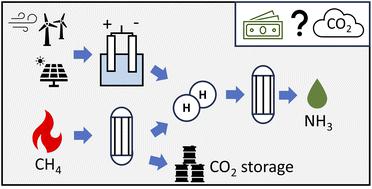当前位置:
X-MOL 学术
›
Sustain. Energy Fuels
›
论文详情
Our official English website, www.x-mol.net, welcomes your feedback! (Note: you will need to create a separate account there.)
A comparative techno-economic assessment of blue, green, and hybrid ammonia production in the United States
Sustainable Energy & Fuels ( IF 5.6 ) Pub Date : 2024-02-15 , DOI: 10.1039/d3se01421e Matthias Mersch 1, 2, 3 , Nixon Sunny 1, 3 , Roghayeh Dejan 1, 3 , Anthony Y. Ku 4 , Gregory Wilson 5 , Sean O'Reilly 5 , Grigorii Soloveichik 6 , John Wyatt 7 , Niall Mac Dowell 1, 3, 4
Sustainable Energy & Fuels ( IF 5.6 ) Pub Date : 2024-02-15 , DOI: 10.1039/d3se01421e Matthias Mersch 1, 2, 3 , Nixon Sunny 1, 3 , Roghayeh Dejan 1, 3 , Anthony Y. Ku 4 , Gregory Wilson 5 , Sean O'Reilly 5 , Grigorii Soloveichik 6 , John Wyatt 7 , Niall Mac Dowell 1, 3, 4
Affiliation

|
Alternatives to fossil fuels as energy carriers are required to reach global climate targets. Hydrogen and ammonia are promising candidates that are carbon emission-free at point of combustion. Ammonia is critically important for fertiliser production and thus global food production. Additionally, low-carbon ammonia is a potentially valuable fuel for shipping, power generation, and industry. However, ammonia production today accounts for about 2% of total global carbon dioxide emissions. Conventional ammonia production based on methane reforming can be decarbonised by using carbon capture and storage, creating so-called blue ammonia. Alternatively, low-carbon electricity from additional clean energy sources can be used for electrolytic (green) hydrogen and ammonia production. Production tax credits (PTC) for clean hydrogen production via the 45V and carbon sequestration via the 45Q under the Inflation Reduction Act (IRA) in the United States have sparked interest in large-scale commercial low-carbon ammonia projects. In this work, we analyse different blue and electrolytic low-carbon ammonia production processes under economic and practical considerations. We propose and evaluate two novel designs: integrating a biomethane supply into the reformer; and combining blue and green ammonia production processes. Results show that all low-carbon ammonia plants can significantly reduce emissions compared to the conventional process. With the production tax credits, blue ammonia is likely to be the most economical production route in the near-term, being cheaper than conventional ammonia which is not eligible for any credits. The economics of electrolytic ammonia depend heavily on the price of reliable low-carbon electricity. A levelised cost of electricity of about 35 $/MWh and lower is required for electrolytic ammonia to be competitive with blue ammonia at average gas prices and upstream emissions. Of the two novel process designs, blending in biomethane shows promise as it can lead to carbon-neutral or even carbon-negative ammonia with a near-zero cost of production when supported by 45V. Blue–green ammonia on the other hand can improve economics if upstream emissions are small and low-carbon electricity is cheap. Overall, the IRA tax credits improve the economics of low-carbon ammonia production significantly and result in it being competitive with conventional ammonia production, enabling significant carbon emission reduction.
中文翻译:

美国蓝氨、绿氨和混合氨生产的比较技术经济评估
为了实现全球气候目标,需要使用化石燃料的替代品作为能源载体。氢气和氨是燃烧时无碳排放的有前途的候选材料。氨对于化肥生产乃至全球粮食生产至关重要。此外,低碳氨对于航运、发电和工业来说是一种潜在的有价值的燃料。然而,目前氨生产量约占全球二氧化碳排放总量的 2%。基于甲烷重整的传统氨生产可以通过碳捕获和储存来脱碳,从而产生所谓的蓝氨。或者,来自其他清洁能源的低碳电力可用于电解(绿色)氢和氨生产。根据美国通货膨胀减少法案 (IRA ),通过45V生产清洁氢气和通过45Q 进行碳封存的生产税收抵免 (PTC) 激发了人们对大型商业低碳氨项目的兴趣。在这项工作中,我们在经济和实用的考虑下分析了不同的蓝色和电解低碳氨生产工艺。我们提出并评估了两种新颖的设计:将生物甲烷供应集成到重整器中;并将蓝氨和绿氨生产工艺相结合。结果表明,与传统工艺相比,所有低碳氨工厂均可显着减少排放。有了生产税收抵免,蓝氨可能是短期内最经济的生产路线,比没有资格获得任何抵免的传统氨便宜。电解氨的经济性在很大程度上取决于可靠的低碳电力的价格。电解氨需要约 35 美元/MWh 或更低的平准化电力成本,才能在平均天然气价格和上游排放方面与蓝氨竞争。在这两种新颖的工艺设计中,混合生物甲烷显示出了前景,因为在 45V 的支持下,它可以产生碳中性甚至负碳氨,且生产成本接近于零。另一方面,如果上游排放量小且低碳电力便宜,蓝绿氨可以提高经济效益。总体而言,爱尔兰共和军税收抵免显着提高了低碳氨生产的经济性,使其与传统氨生产相比具有竞争力,从而显着减少碳排放。
更新日期:2024-02-15
中文翻译:

美国蓝氨、绿氨和混合氨生产的比较技术经济评估
为了实现全球气候目标,需要使用化石燃料的替代品作为能源载体。氢气和氨是燃烧时无碳排放的有前途的候选材料。氨对于化肥生产乃至全球粮食生产至关重要。此外,低碳氨对于航运、发电和工业来说是一种潜在的有价值的燃料。然而,目前氨生产量约占全球二氧化碳排放总量的 2%。基于甲烷重整的传统氨生产可以通过碳捕获和储存来脱碳,从而产生所谓的蓝氨。或者,来自其他清洁能源的低碳电力可用于电解(绿色)氢和氨生产。根据美国通货膨胀减少法案 (IRA ),通过45V生产清洁氢气和通过45Q 进行碳封存的生产税收抵免 (PTC) 激发了人们对大型商业低碳氨项目的兴趣。在这项工作中,我们在经济和实用的考虑下分析了不同的蓝色和电解低碳氨生产工艺。我们提出并评估了两种新颖的设计:将生物甲烷供应集成到重整器中;并将蓝氨和绿氨生产工艺相结合。结果表明,与传统工艺相比,所有低碳氨工厂均可显着减少排放。有了生产税收抵免,蓝氨可能是短期内最经济的生产路线,比没有资格获得任何抵免的传统氨便宜。电解氨的经济性在很大程度上取决于可靠的低碳电力的价格。电解氨需要约 35 美元/MWh 或更低的平准化电力成本,才能在平均天然气价格和上游排放方面与蓝氨竞争。在这两种新颖的工艺设计中,混合生物甲烷显示出了前景,因为在 45V 的支持下,它可以产生碳中性甚至负碳氨,且生产成本接近于零。另一方面,如果上游排放量小且低碳电力便宜,蓝绿氨可以提高经济效益。总体而言,爱尔兰共和军税收抵免显着提高了低碳氨生产的经济性,使其与传统氨生产相比具有竞争力,从而显着减少碳排放。



























 京公网安备 11010802027423号
京公网安备 11010802027423号